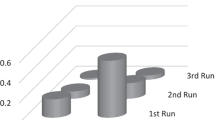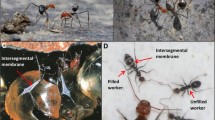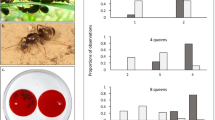Summary
-
1.
Field studies of the honey ant Myrmecocystus mimicus have revealed that colonies are often founded by groups of foundresses ranging in size from 2–9 females, with groups of 2–4 females being most common. Founding nests are also aggregated together in patches which are distant from existing M. minicus colonies.
-
2.
Laboratory experiments have shown that colony founding involves inter-colony raiding: the brood from neighboring incipient colonies is transported by workers from one nest to another. Ultimately all of the brood ends up in a single nest chamber which the workers adopt as their own. Workers frequently abandon their mothers in favor of these nests. We conclude that competition among founding nests favors foundress associations and that inter-colony raiding is a natural consequence of aggregated pleometrotic founding nests.
-
3.
A general theory of the evolution of foundress associations is developed which describes the conditions under which foundress associations will be favored. It is shown that the evolution of foundress groups of particular sizes depends on the shape of the colony productivity function. Increasing relatedness among foundresses will generally result in a larger optimum foundress group size. Production data on foundress groups of different sizes gathered in the laboratory on M. mimicus are analyzed using the theory developed. It is shown that the size of foundress associations expected on the basis of the theory is very near the value observed in nature.
Similar content being viewed by others
References
Baroni Urbani C (1968) Monogyny in ant societies. Zool Anz 181:269–277
Baroni Urbani C, Soulié J (1962) Monogynie chez la fourmi Crematogaster scutellaris. Bull Soc Hist Nat (Toulouse) 97:29–34
Batra SWT (1966) Social behavior and nests of some nomine bees in India. Insectes Soc 13:145–154
Buschinger A (1968) Mono-und Polygynie bei Arten der Gattung Lepthorax Mayr (Hymenoptera: Formicidae). Insectes Soc 15:217–226
Buschinger A (1974) Monogynie und Polygynie in Insektensozietäten. In: Schmidt GH (ed) Sozialpolymorphismus bei Insekten. Wissenschaftliche Verlagsgesellschaft, Stuttgart, pp 862–896
Buttel-Reepen H V (1905) Soziologisches und Biologisches vom Ameisen- und Bienenstaat. Wie entsteht eine Amerisenkolonie? Arch Rass Ges Biol 2:1–16
Eidmann H (1926) Die Koloniegründung der einheimischen Ameisen. Z Vergl Physiol 3:776–826
Eidmann H (1928) Weitere Beobachtungen über die Koloniegründung einheimischer Ameisen. Z Vergl Physiol 7:39–55
Forsyth A (1980) Worker control of queen density in hymenopteran societies. Am Nat 116:895–898
Gamboa GF (1978) Intraspecific defense: advantage of social cooperation among paper wasp foundresses. Science 199:1463–1465
Gibo DL (1974) A laboratory study of the selective advantage of foundress associations in Polistes fuscatus. Can Entomol 106:101–106
Gibo DL (1978) The selective advantage of foundress associations in Polistes fuscatus: a field study of the effects of predation of productivity. Can Entomol 110:519–540
Haskins CP, Haskins EF (1951) Note on the method of colony foundation of the ponerine ant Amblyopone australis Erichson. Am Midl Nat 45:432–445
Haskins CP, Haskins EF (1955) The pattern of colony foundation in the archaic ant Myrmecia regulatis. Inseetes Soc 2:115–126
Hölldobler B (1962) Zur Frage der Oligogynie bei Camponotus ligniperda Latr und Camponotus herculeanus L. (Hym. Formicidae). Z Angew Entomol 49:337–352
Hölldobler B (1976) Tournaments and slavery in a desert ant. Science 192:912–914
Hölldobler B (1981) Foraging and spatiotemporal territories in the honey ant Myrmecocystus mimicus Wheeler (Formicidae: Hymenoptera). Behav Ecol Sociobiol 9:301–314
Hölldobler B, Wilson EO (1977) The number of queens: An important trait in ant evolution Naturwissenschaften 64:8–15
Hölldobler K (1938) Weitere Beiträge zur Koloniegründung der Ameisen. Zool Anz 121:66–72
Klahn JE (1979) Philopatric and nonphilopatric foundress associations in the Social Wasp Polistes fuscatus. Behav Ecol Sociobiol 5:417–424
Lin N (1964) Increased parasitic pressure as a major factor in the evolution of social behavior in halictine rees. Insectes Soc 11:187–192
Litte M (1977) Behavioral ecology of the social wasp Mischocyttarus mexicanus. Behav Ecol Sociobiol 2:229–246
Markin GP, Collins HL, Dillier JH (1972) Colony founding by queens of the red imported fire ant, Solenopsis invicta. Ann Entomol Soc Am 65:1053–1058
Masne G Le, Bonavita A (1969) La fondation des sociétés selon le “type Myrmecia” chez la Fourmi Manica rubra Latr Proc VI Congr JUSSI, Bern, pp 137–147
Metcalf RA, Whitt GS (1977) Intra-nest relatedness in the social wasp Polistes metricus. Behav Ecol Sociobiol 2:339–357
Michener CD (1958) The evolution of social behavior in bees. Proc Tenth Int Congr Entomol (Montreal) 2:441–447
Michener CD (1958) The social behavior of bees. Belknap Press of Harvard University Press, Cambridge, MA
Mintzer A (1979) Colony foundation and pleometrosis in Camponotus (Hymenoptera: Formicidae). Pan Pac Entomol 55:81–89
Mrazek A (1906) Gründung neuer Kolonien bei Lasius niger. Z Wiss Insektenbiol 2:109–111
Pickering J (1980) Sex ratio, social behavior and ecology in Polistes, Pachysomoides, and Plasmodium. Ph D thesis, Harvard University, Cambridge, MA
Schmitz H (1911) Über die selbständige Koloniegründung und die Folgen künstlicher Pleometrose bei Camponotus ligniperda Latr. Dtsch Entomol Natl Bibl 2:166–168
Schneirla TC (1956) A preliminary survery of colony division and related processes in two species of terrestrial army ants. Insectes Soc 3:49–69
Schneirla TC (1971) Army ants. Freeman, San Francisco
Snelling RR (1976) A revision of the honey ants, genus Myrmecocystus (Hymenoptera: Formicidae). Nat Hist Mus Los Angeles Cty Sci Bull 24:163
Stumper R (1962) Sur un effet de groupe chez les femelles de Camponotus vagus (Scopoli). Insectes Soc 9:329–333
Taki A (1976) Colony founding of Messor aciculatum (Fr. Smith) (Hymenoptera: Formicidae) by single and grouped queens. Physiol Ecol Jpn 17:503–512
Tschinkel WR, Howard DF (1979) Queen replacement in orphaned colonies of the fire ant, Solenopsis invicta. Behav Ecol Sociobiol 3:297–310
Waloff N (1957) The effect of the number of queens of the ant Lasius flavus (Fab.) (Hym. Formicidae) on their survival and on the rate of development of the first brood. Insectes Soc 4:391–408
Weber NA (1972) Gardening ants, the attines. Mem Am Philos Soc 92:146
West-Eberhard MJ (1969) The social biology of polistine wasps. Misc Publ Mus Zool Univ Mich 109:1–101
West-Eberhard MJ (1978) Polygyny and the evolution of social behavior in wasps. J Kans Entomol Soc 51:832–856
Wheeler WM (1917) The pleometrosis of Myrmecocystus. Psyche 24:180–182
Wheeler WM (1933) Colony-founding among ants, with an account of some primitive Australian species. Harvard Univ Press, Cambridge, MA
Wilson EO (1966) Behavior of social insects. Symp R Entomol Soc (Lond) 3:81–96
Wilson EO (1971) The insect societies. Belknap Press of Harvard University Press, Cambridge, MA
Author information
Authors and Affiliations
Additional information
Dedicated to Dr. H. Kutter on the occasion of his 85th birthday
Rights and permissions
About this article
Cite this article
Bartz, S.H., Hölldobler, B. Colony founding in Myrmecocystus mimicus wheeler (Hymenoptera: Formicidae) and the evolution of foundress associations. Behav Ecol Sociobiol 10, 137–147 (1982). https://doi.org/10.1007/BF00300174
Received:
Accepted:
Issue Date:
DOI: https://doi.org/10.1007/BF00300174




